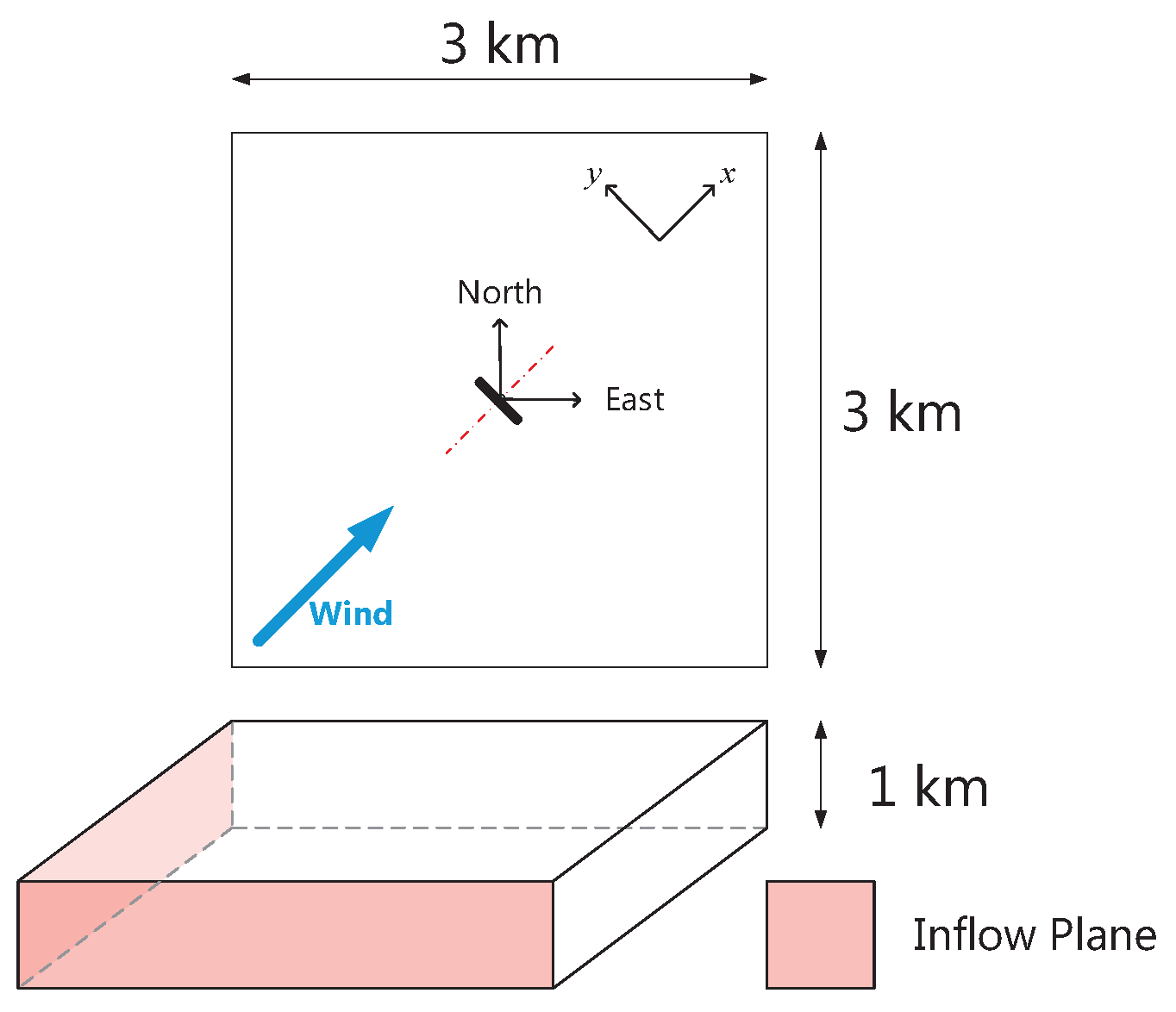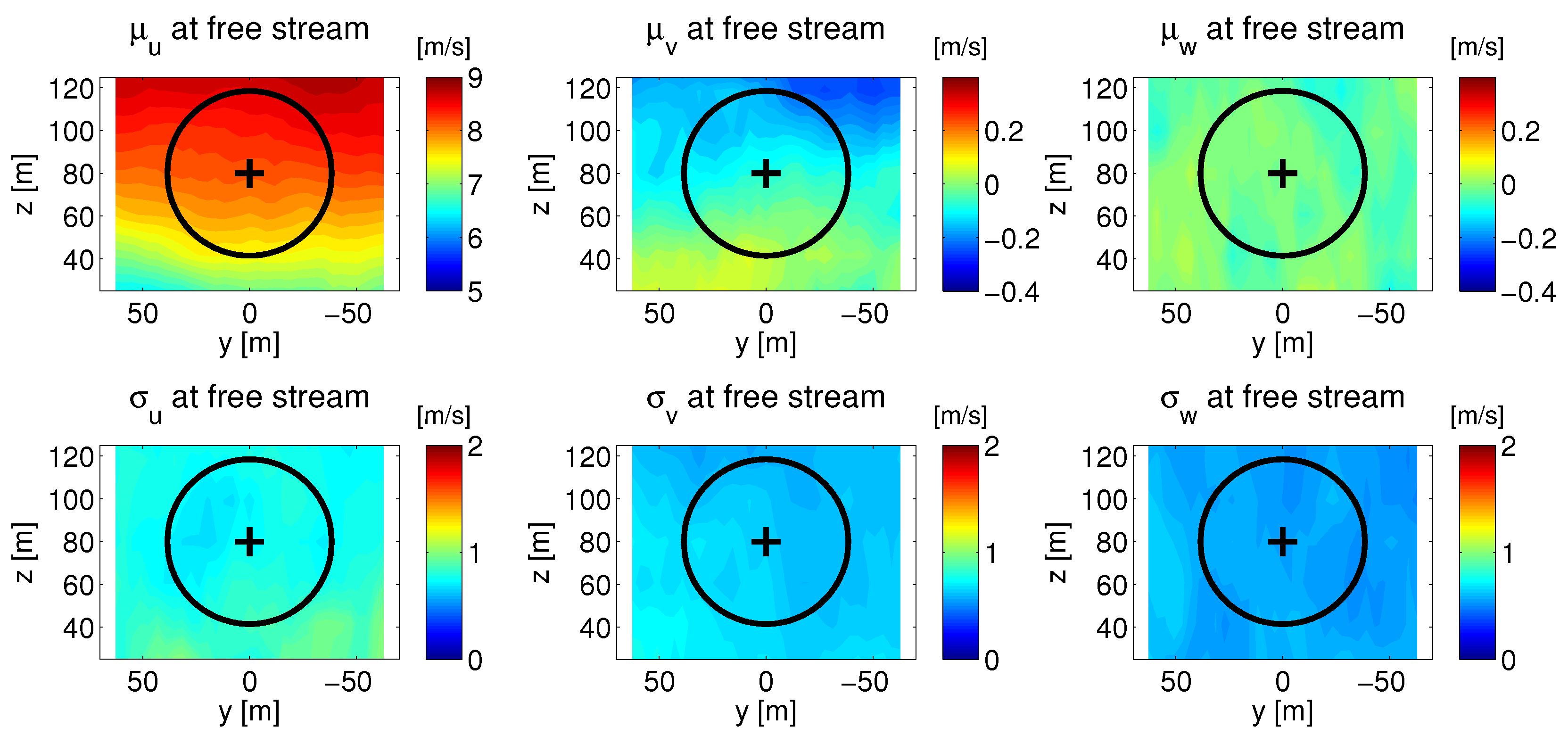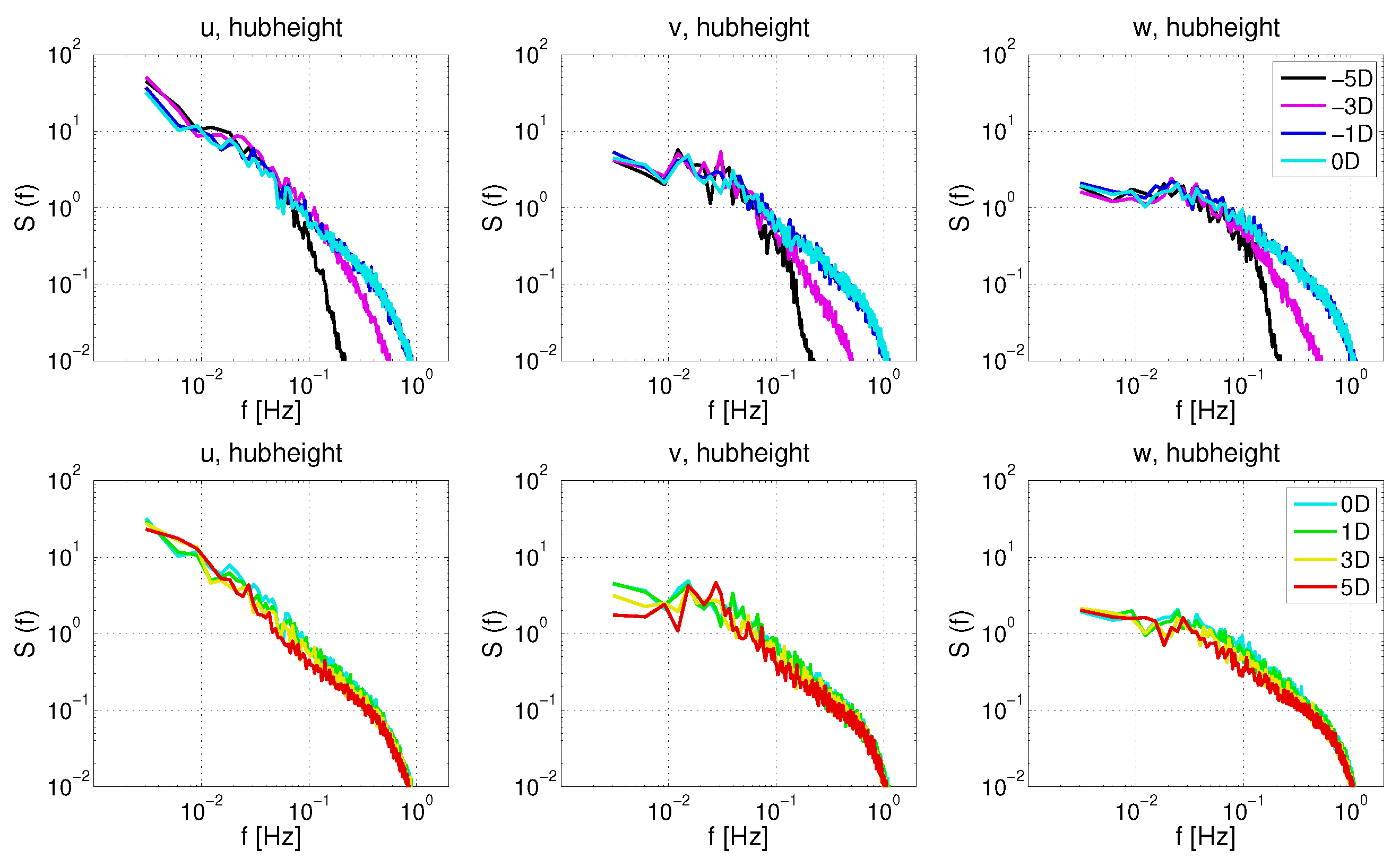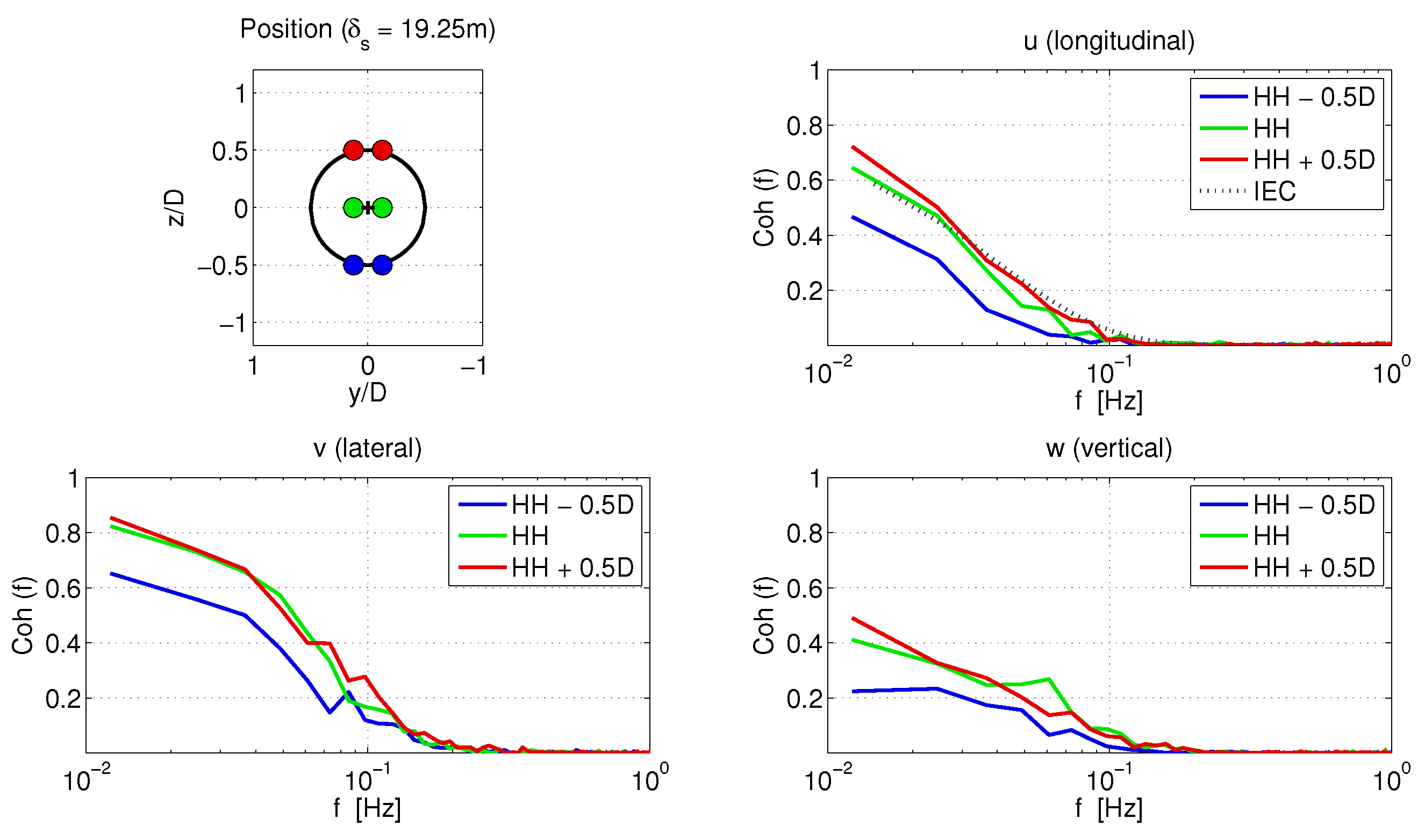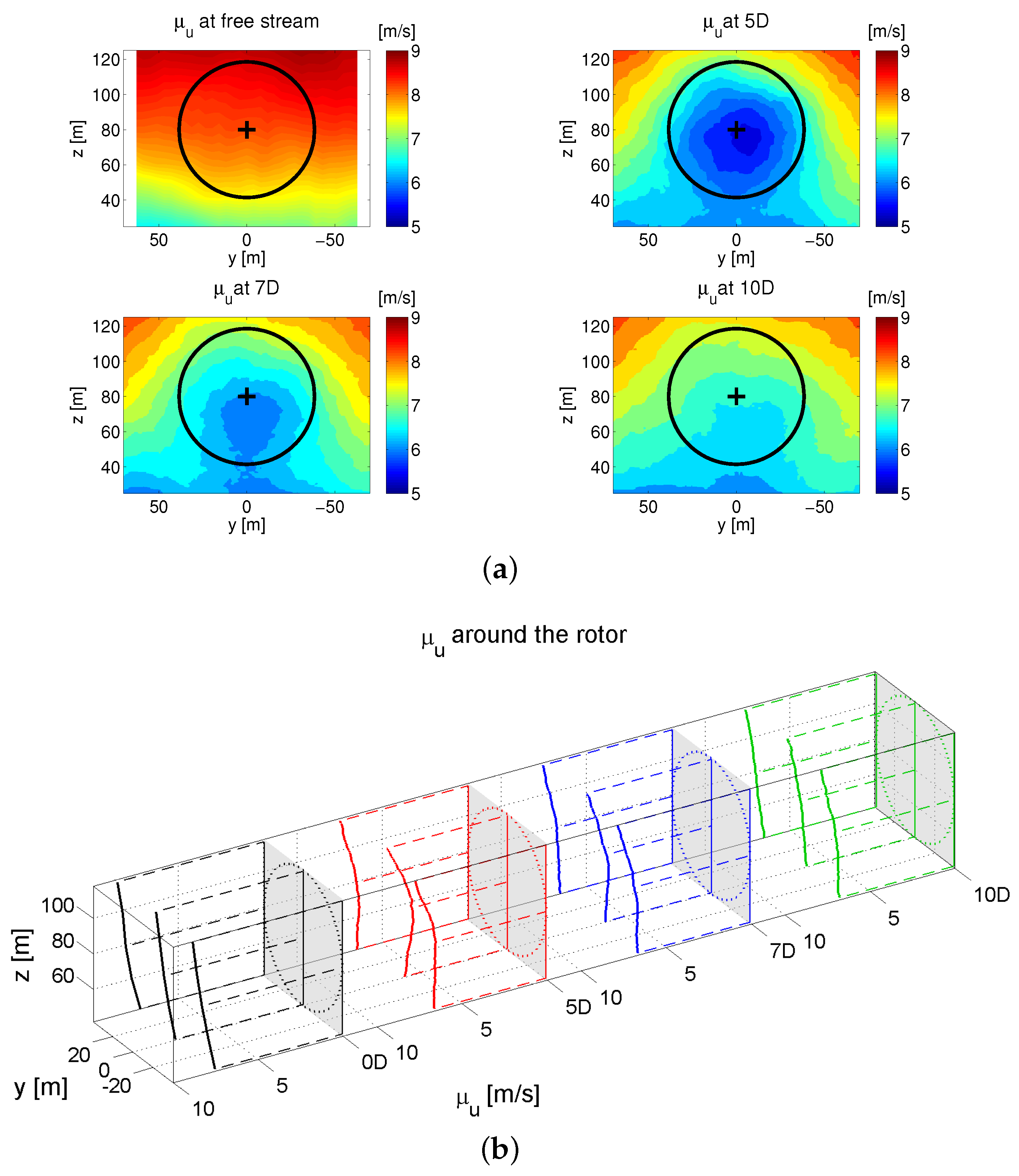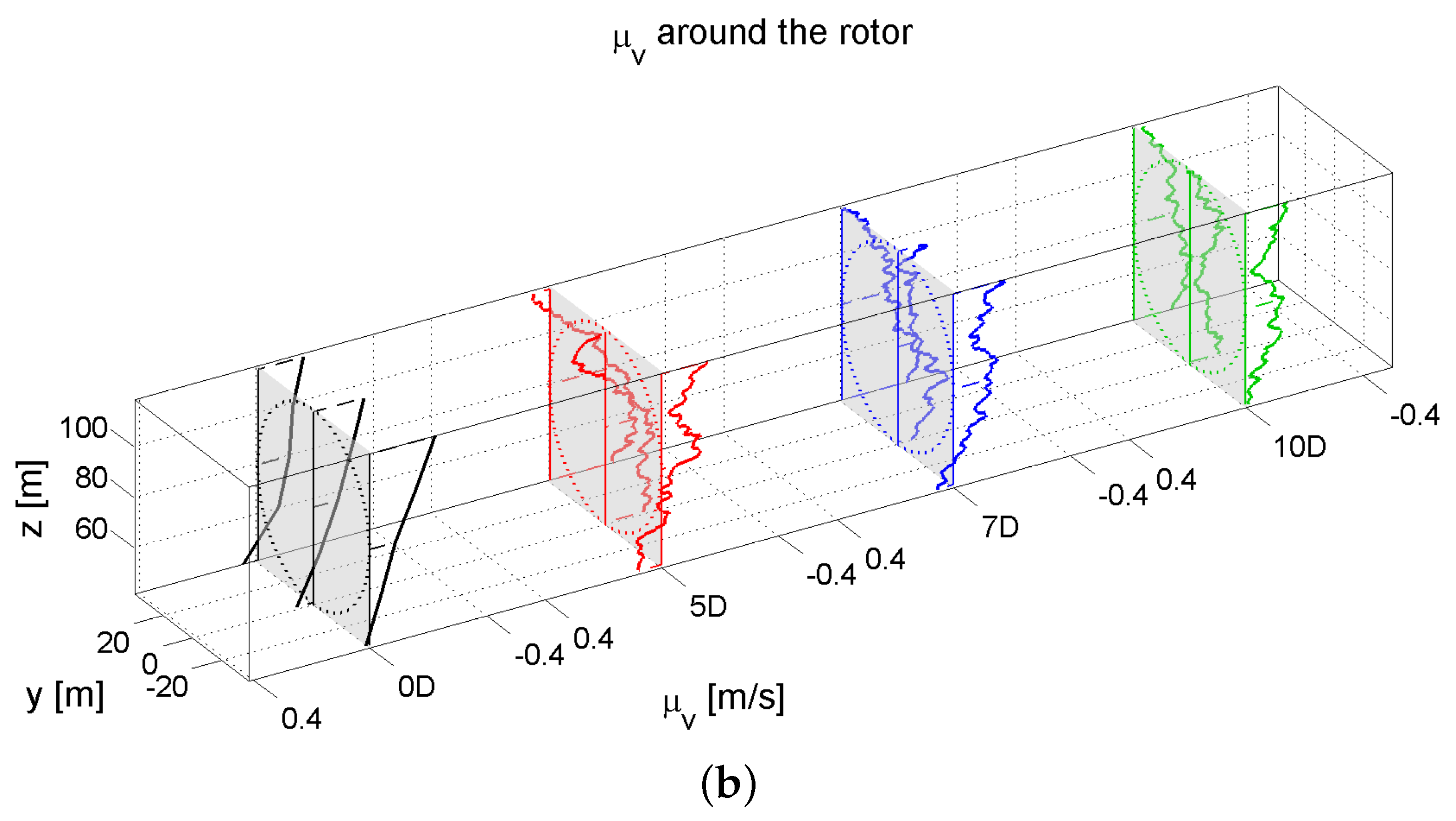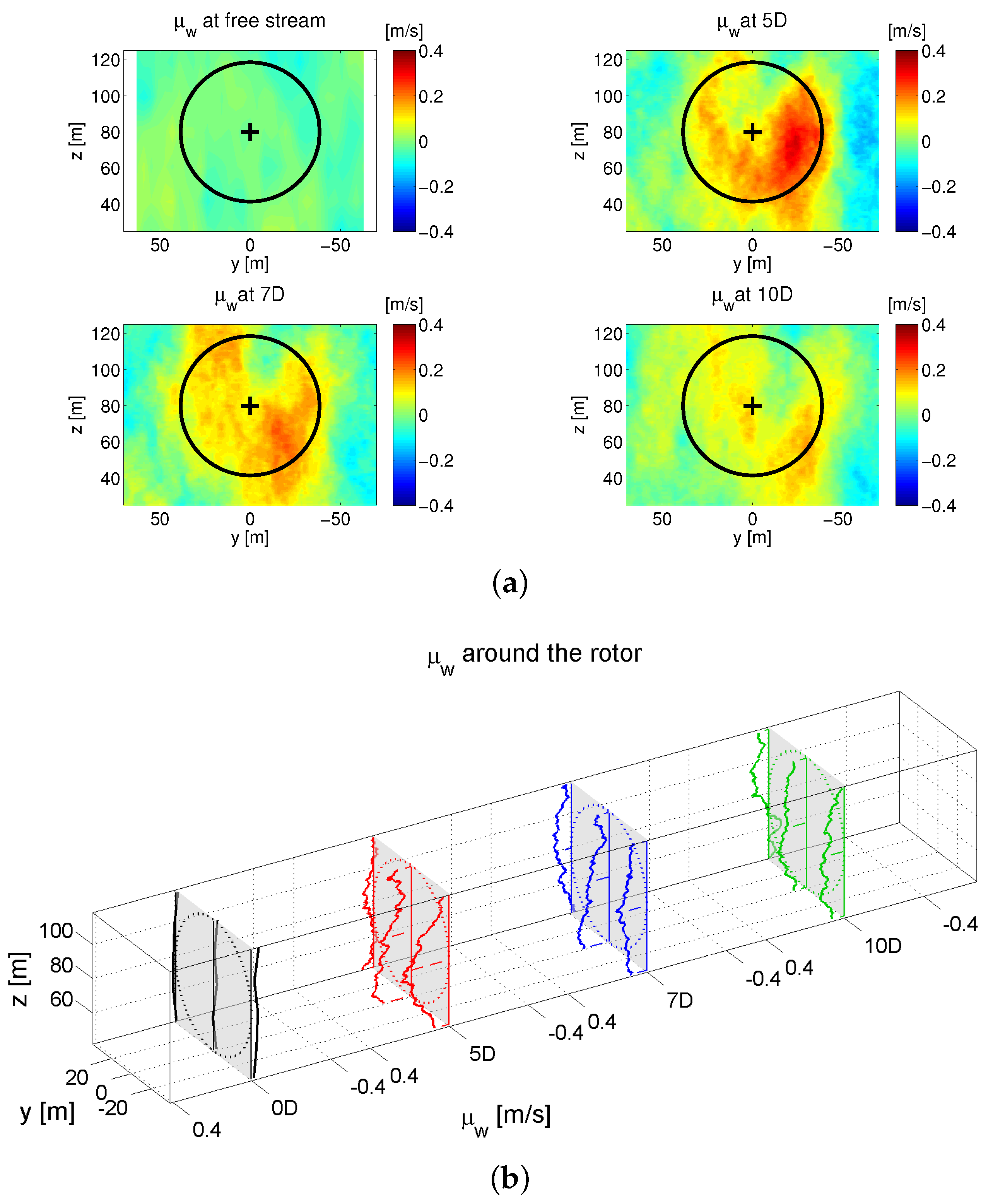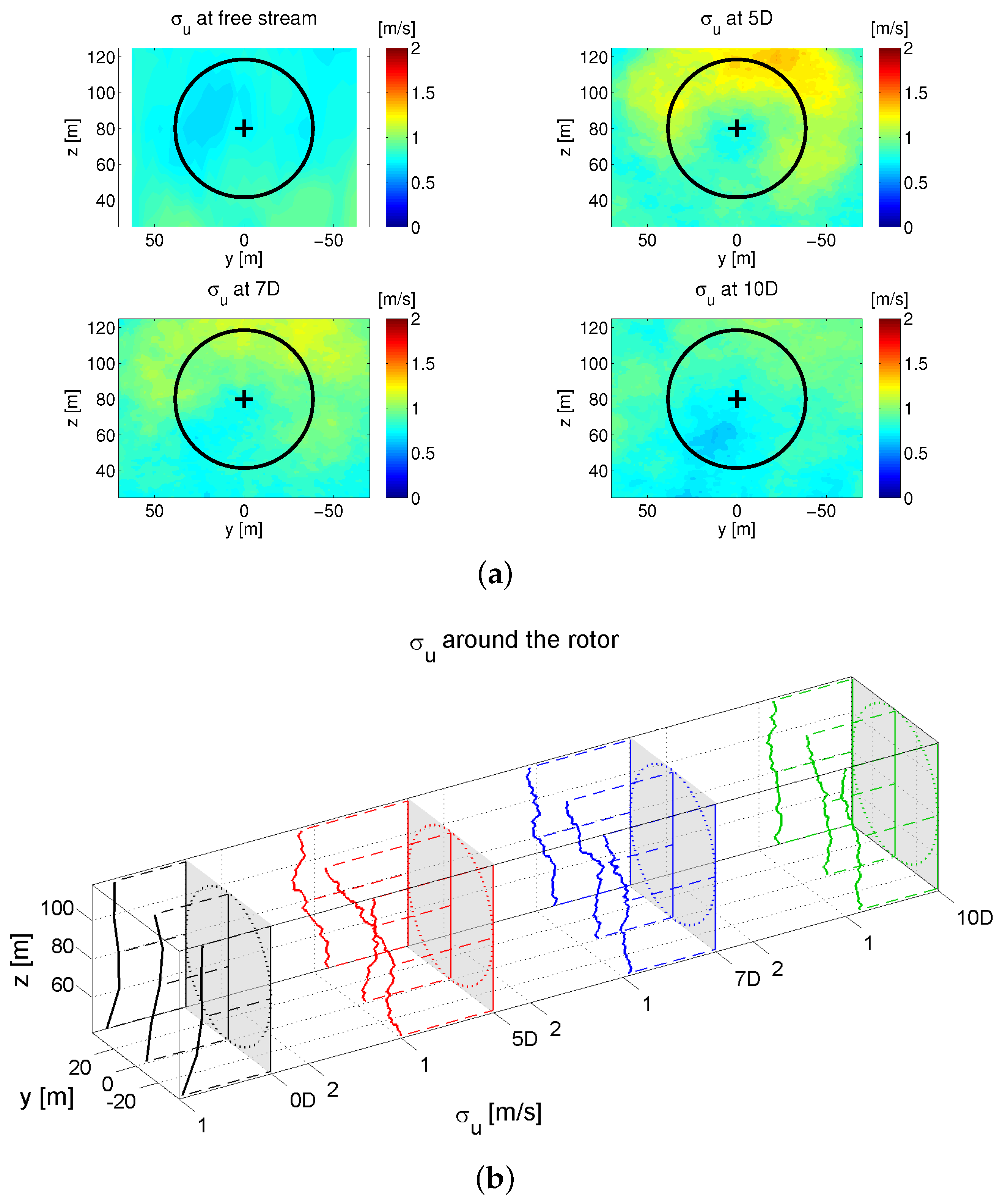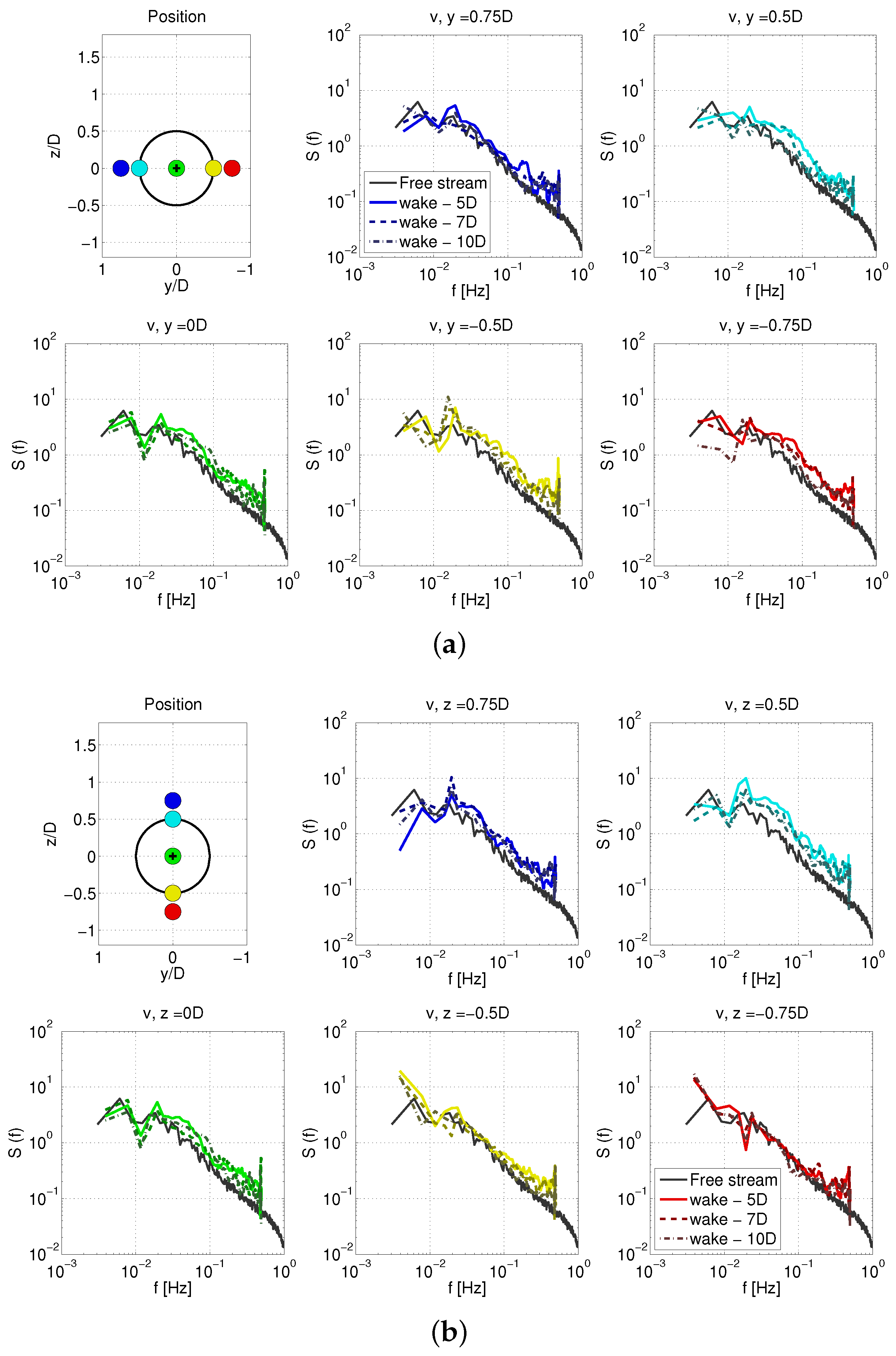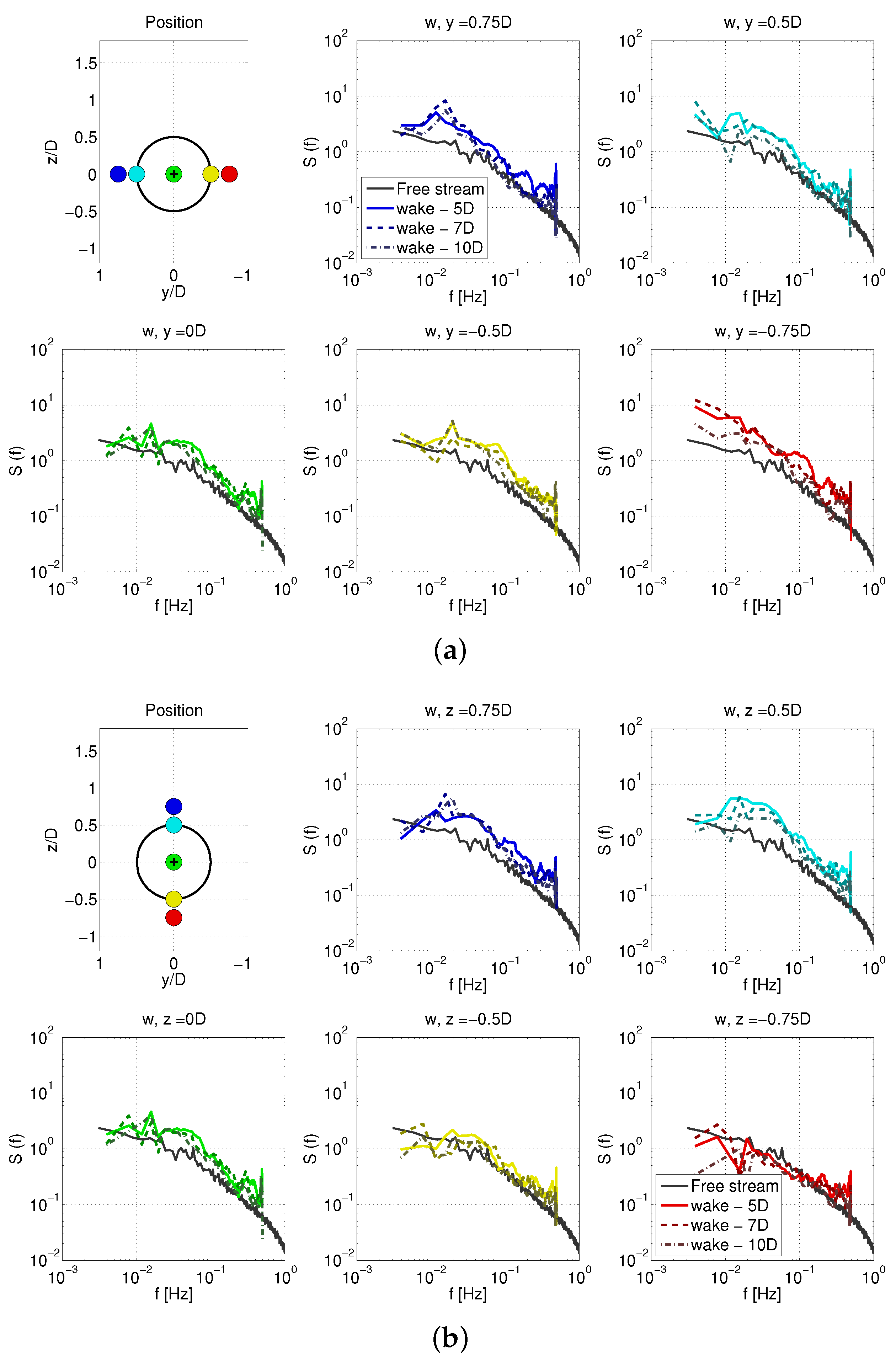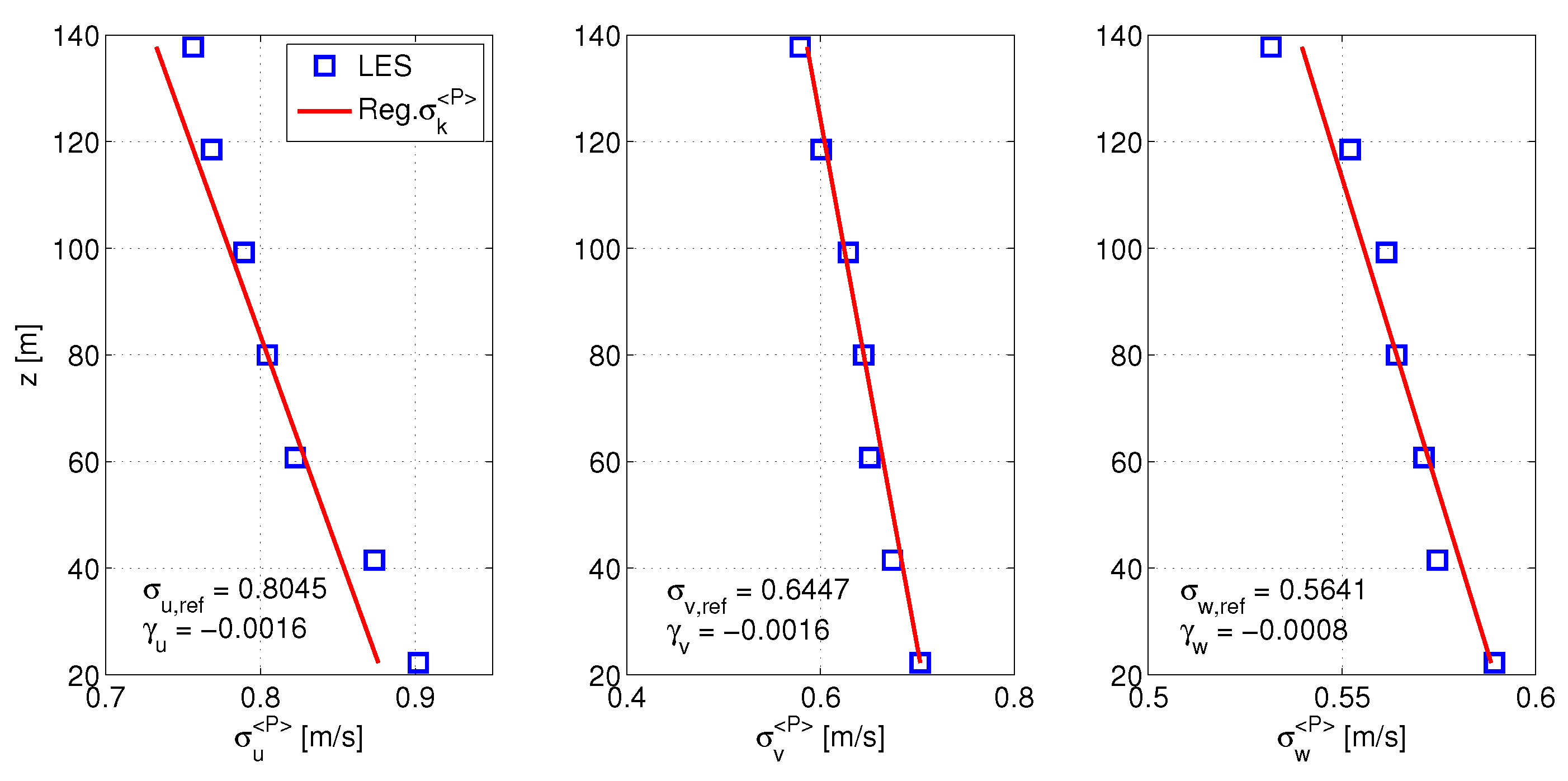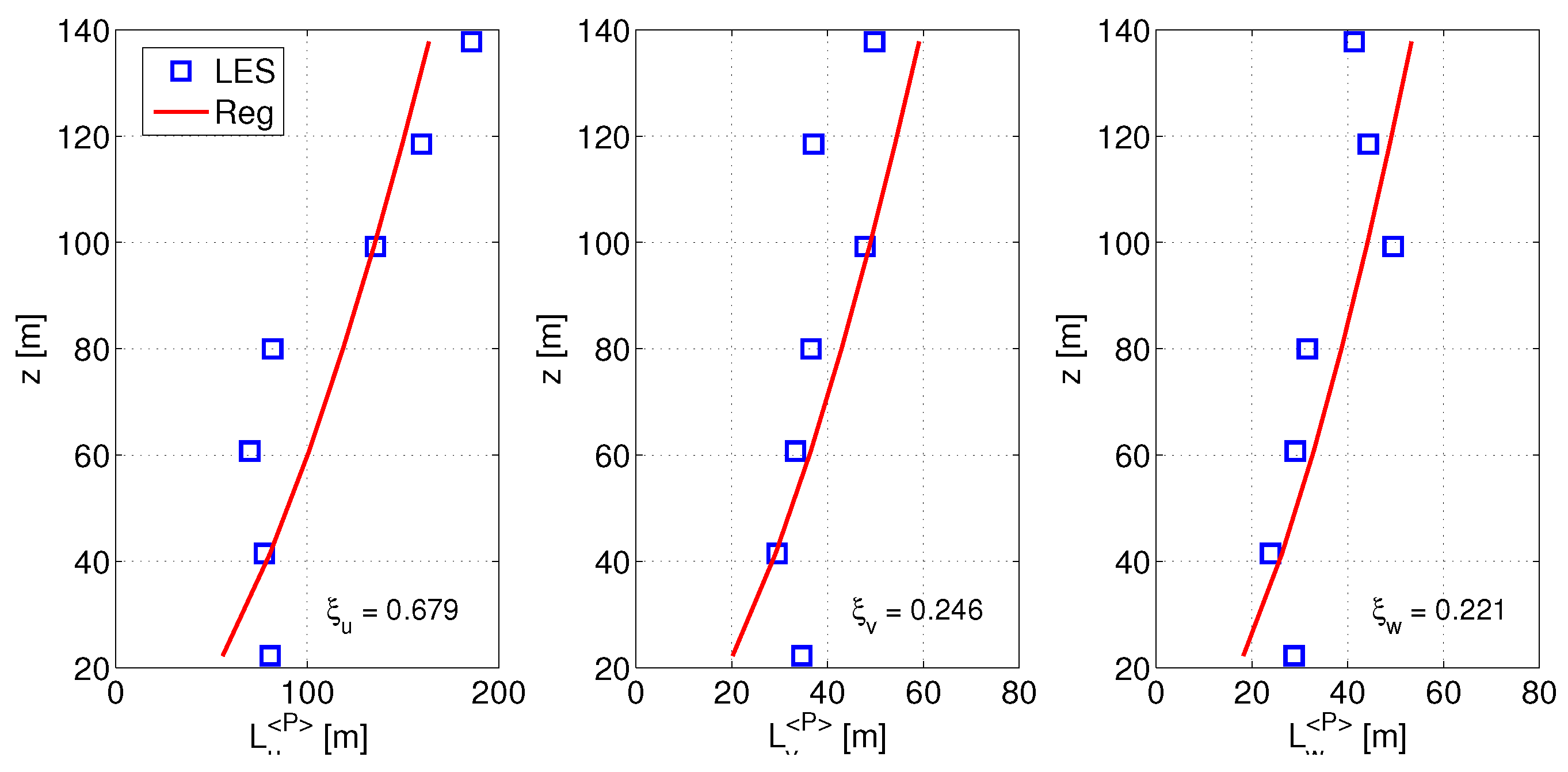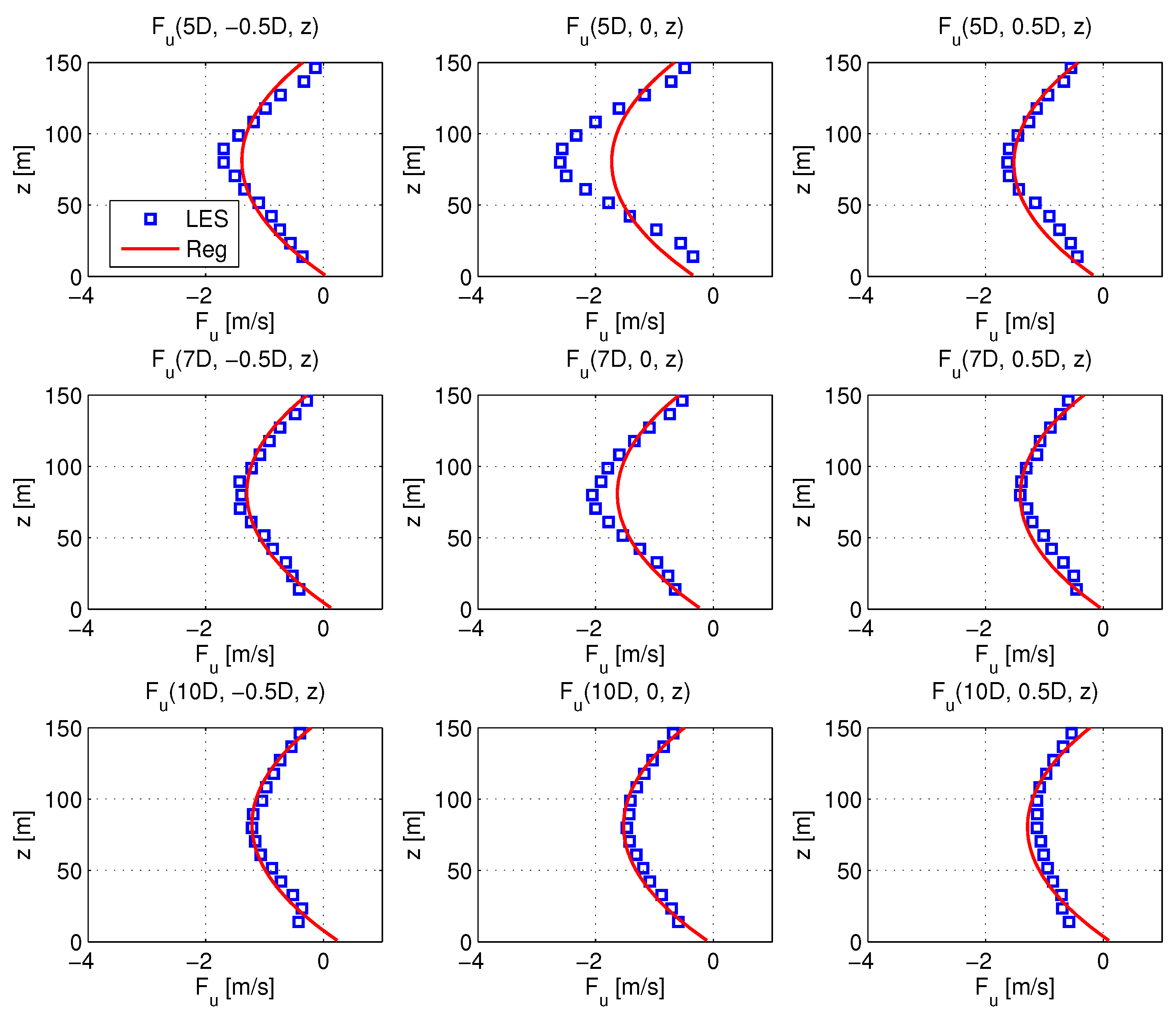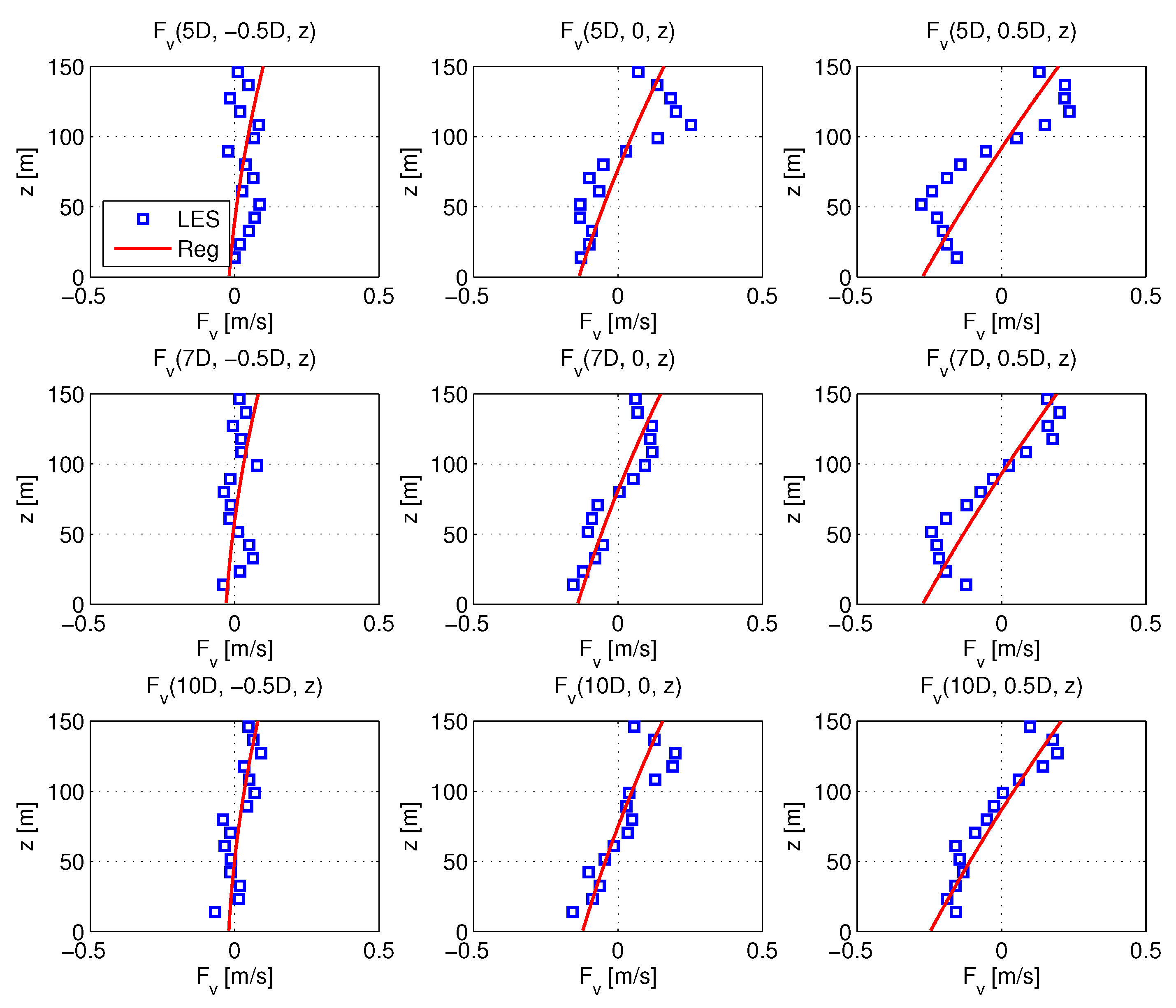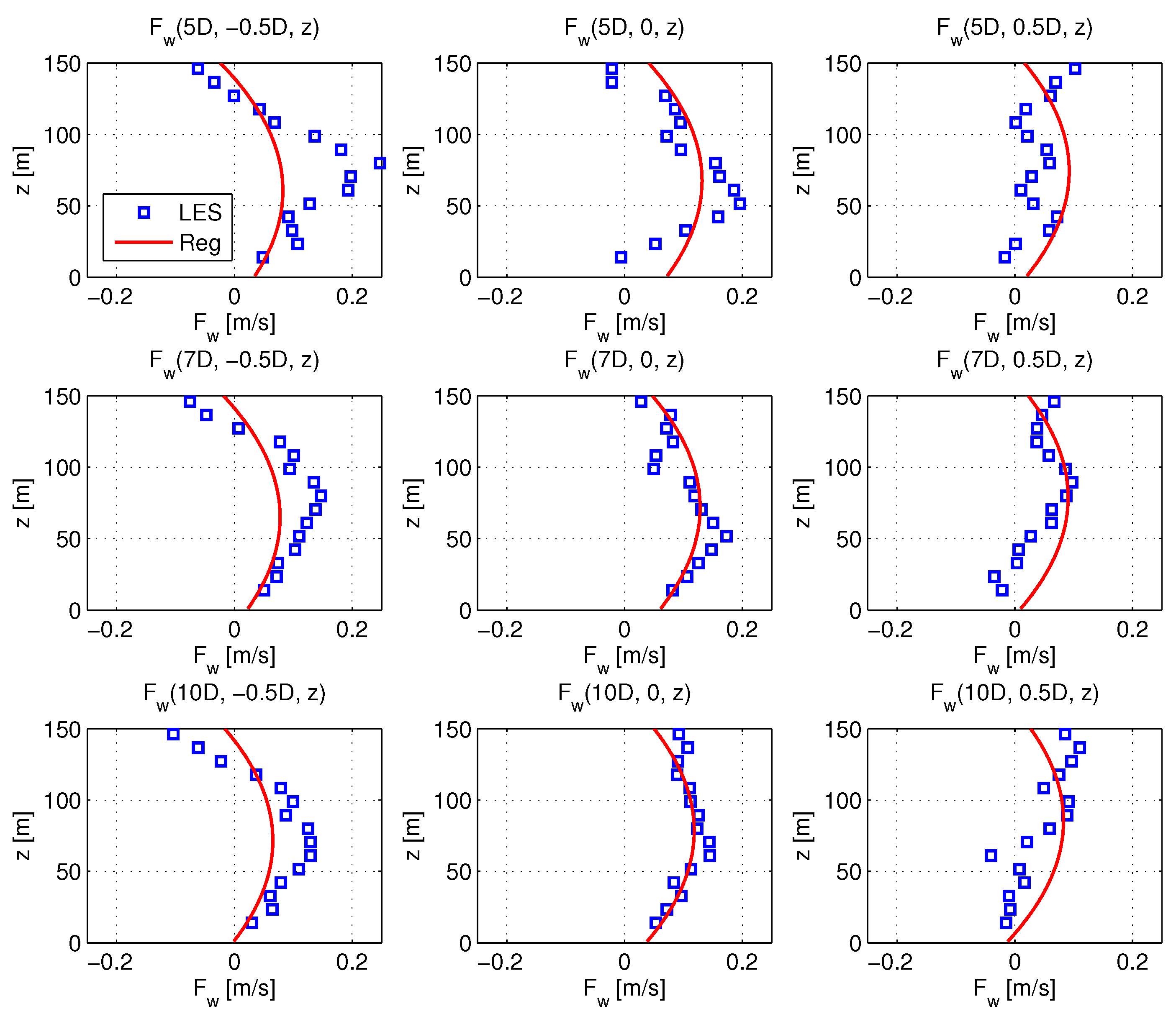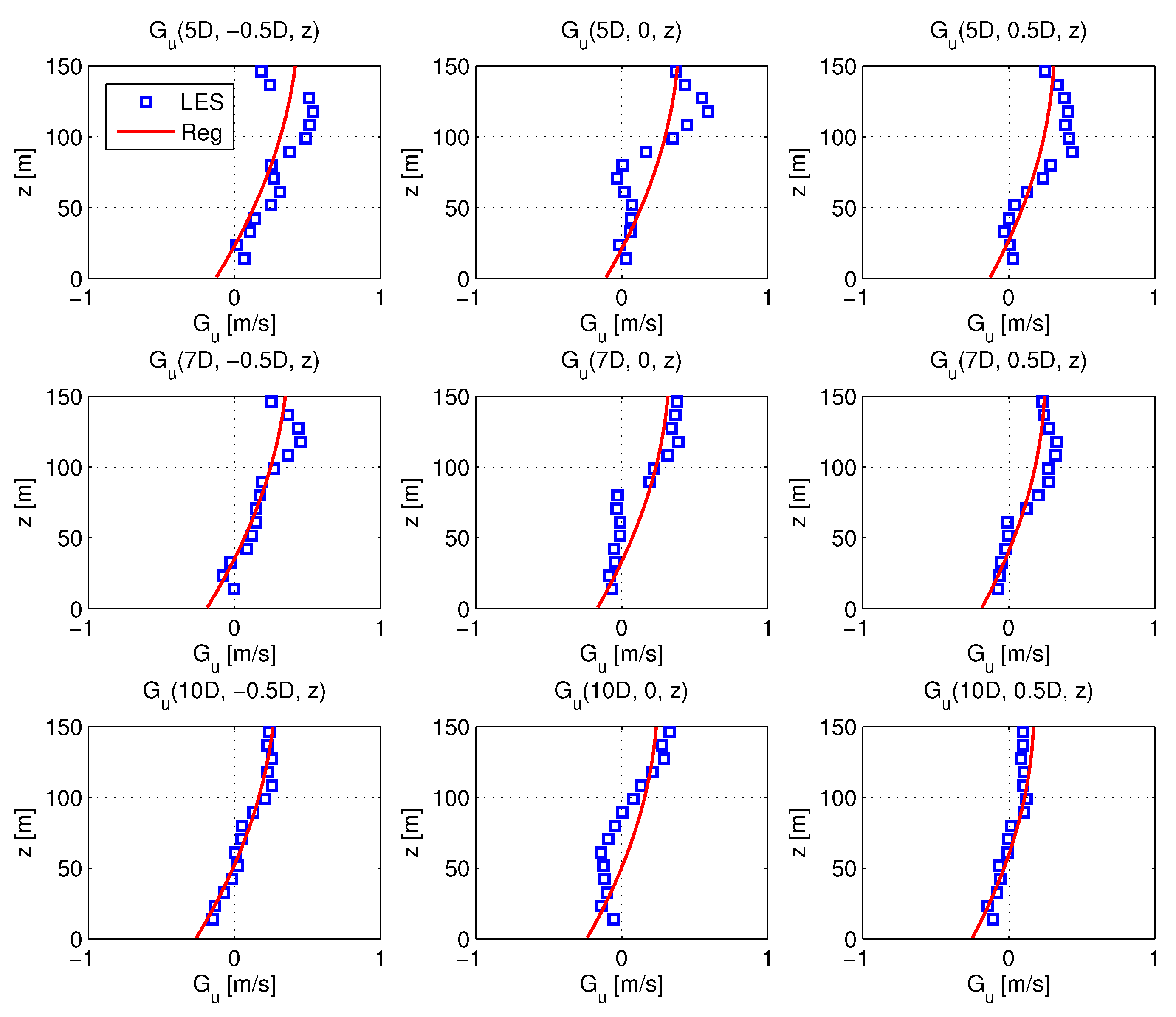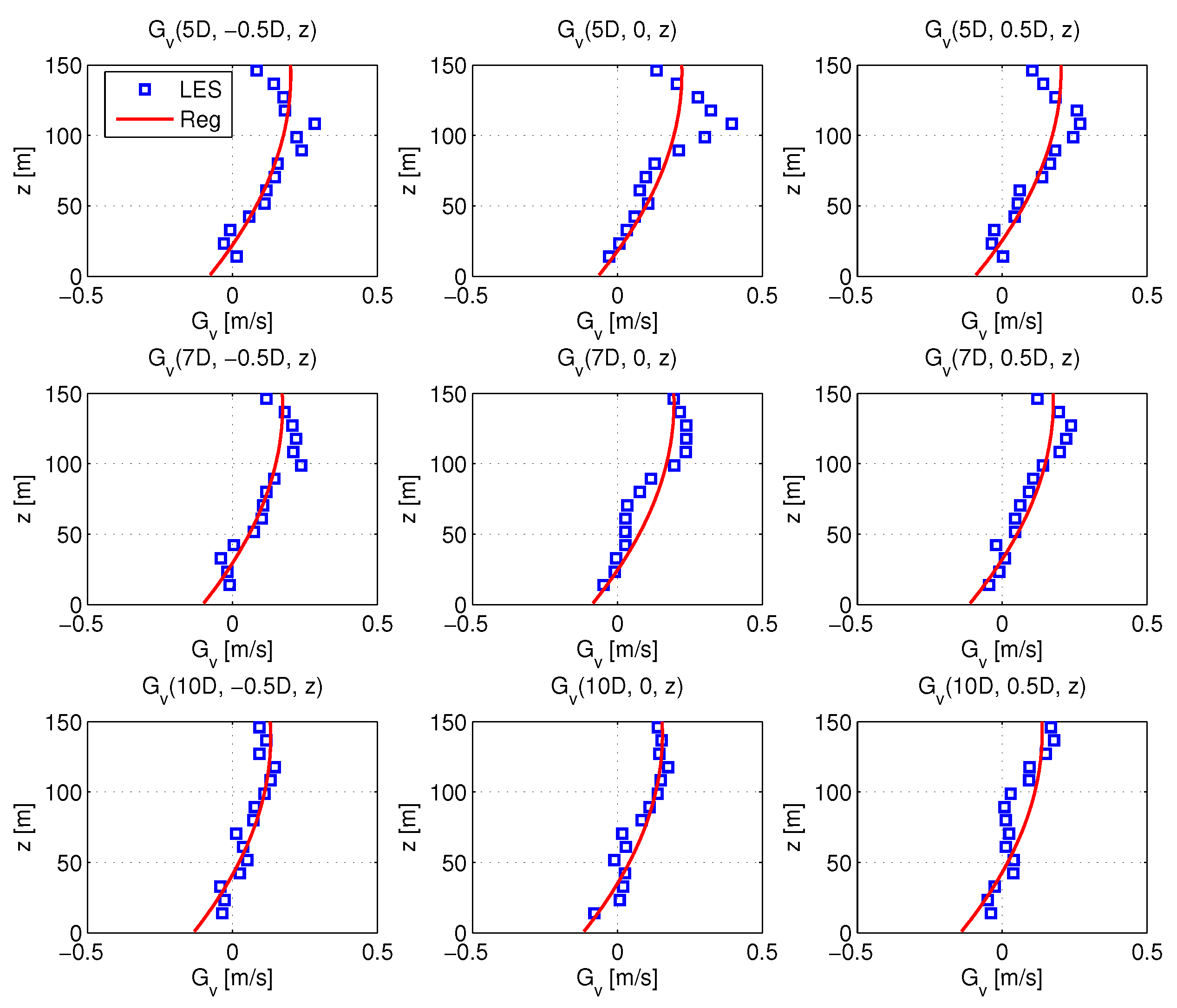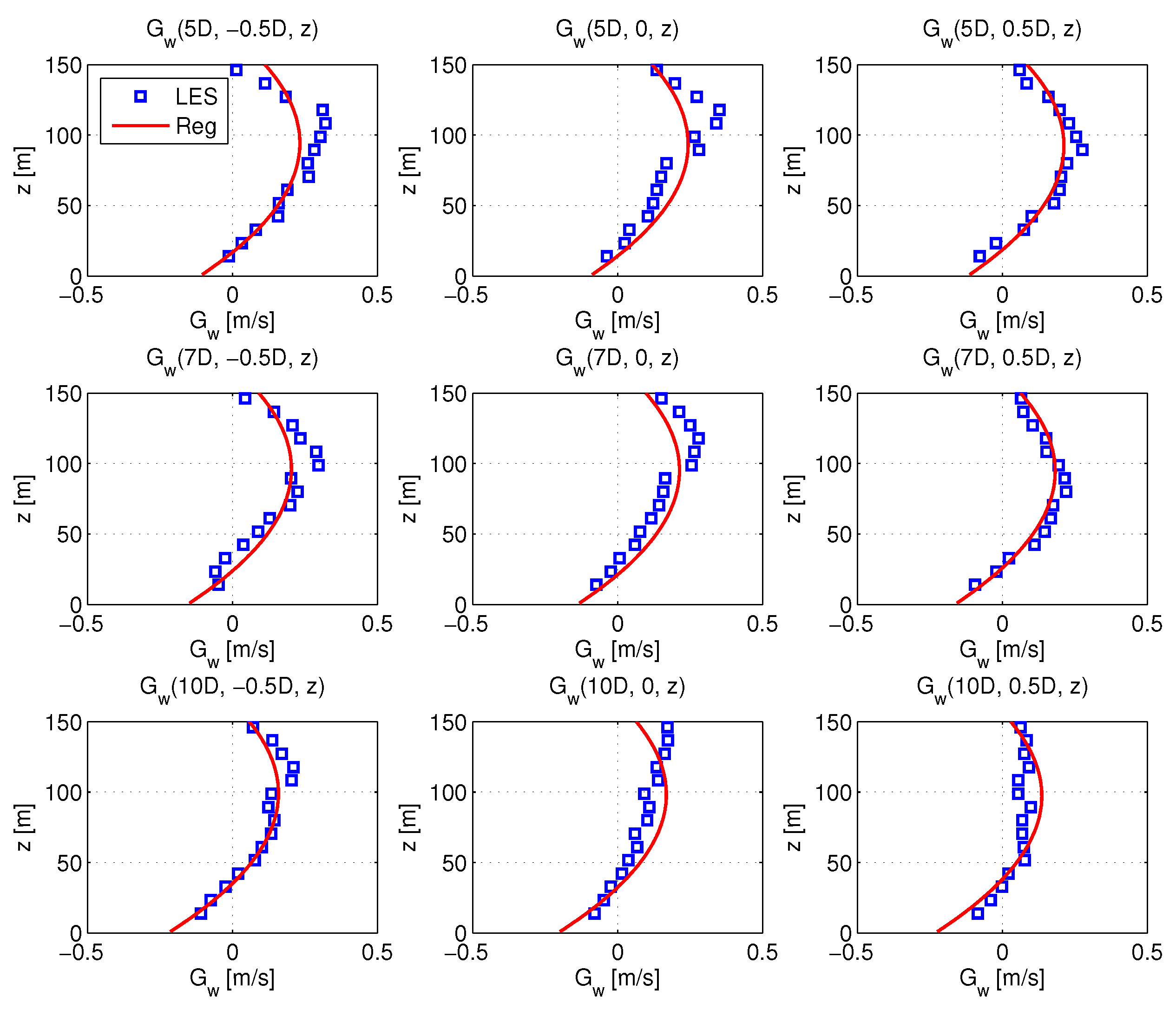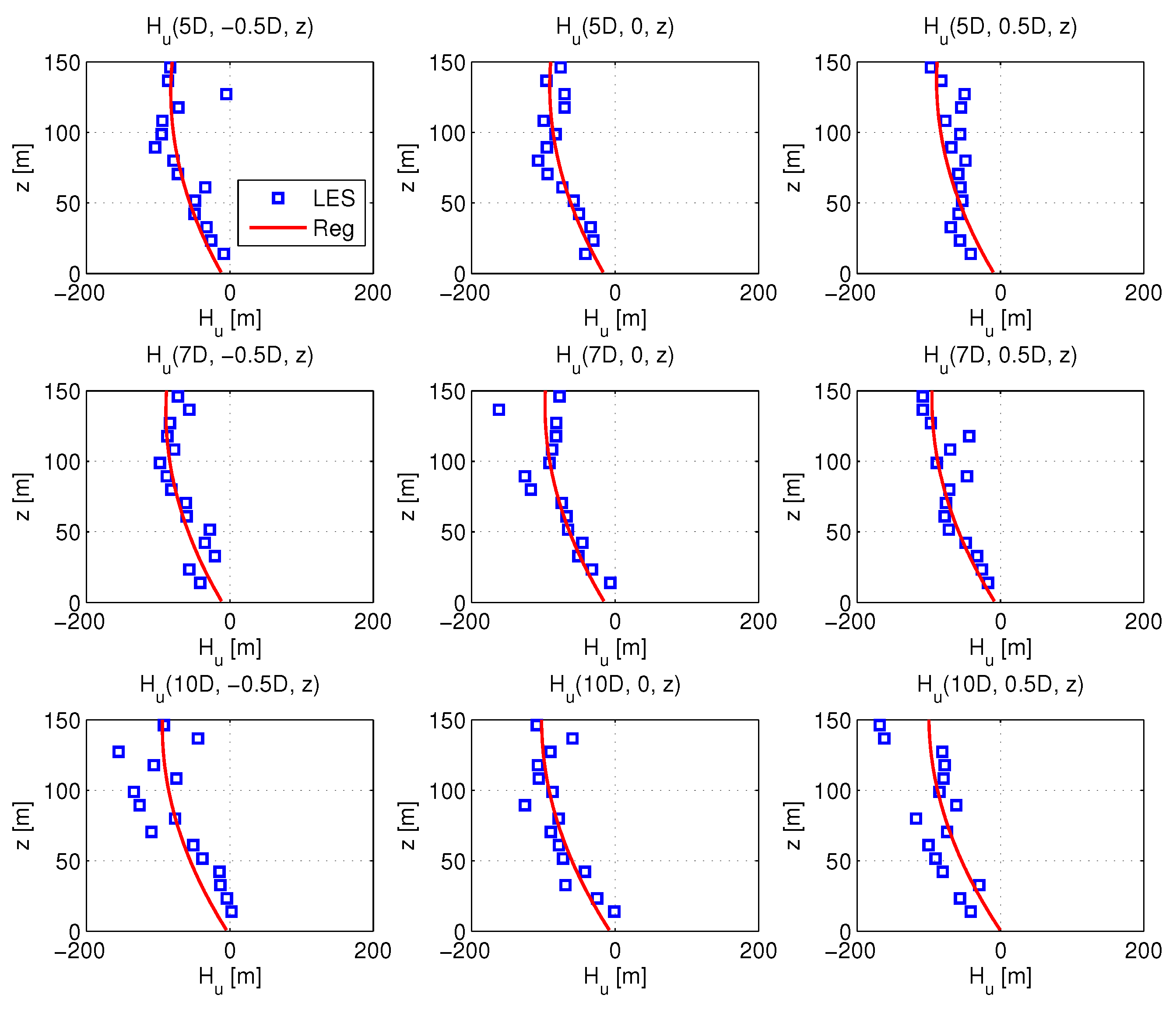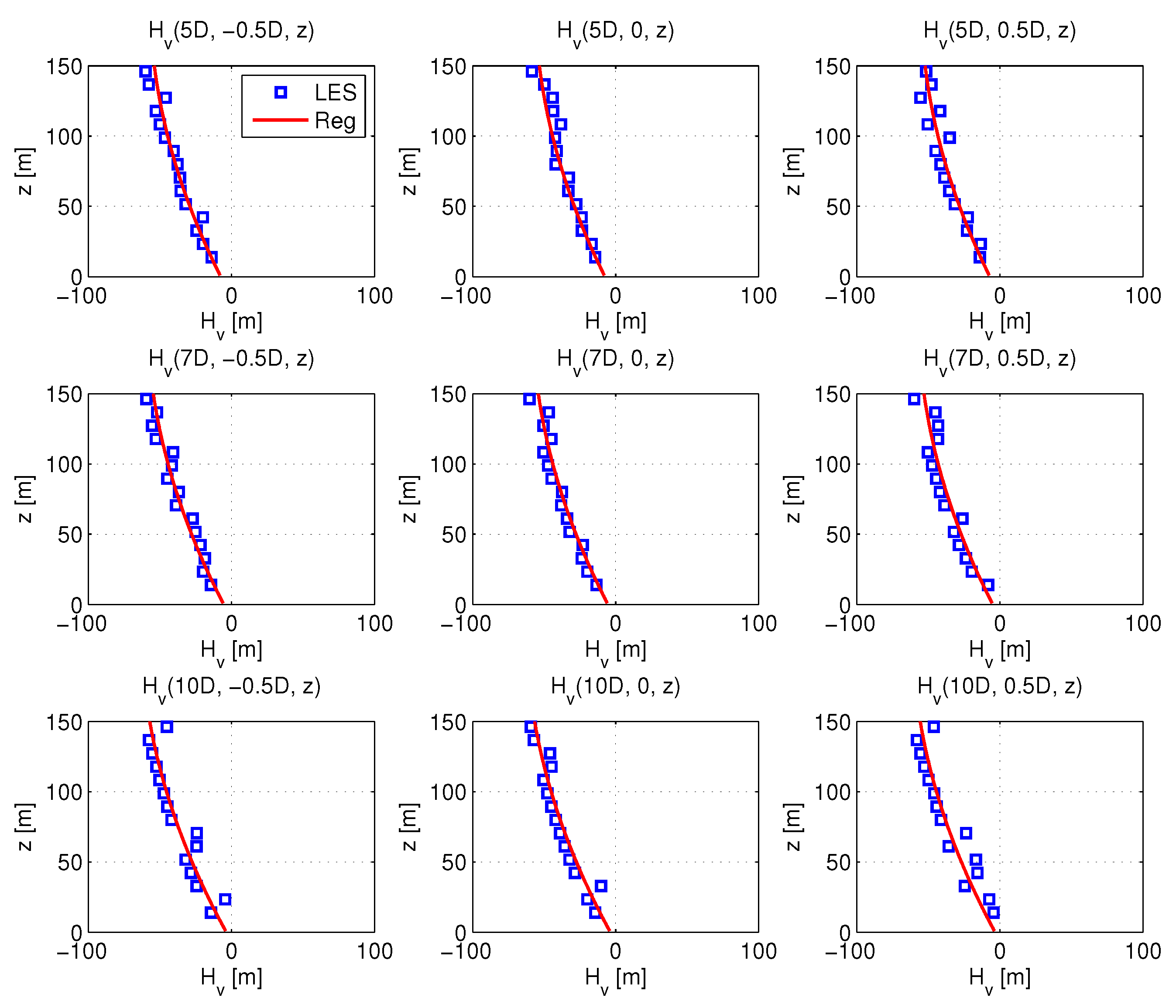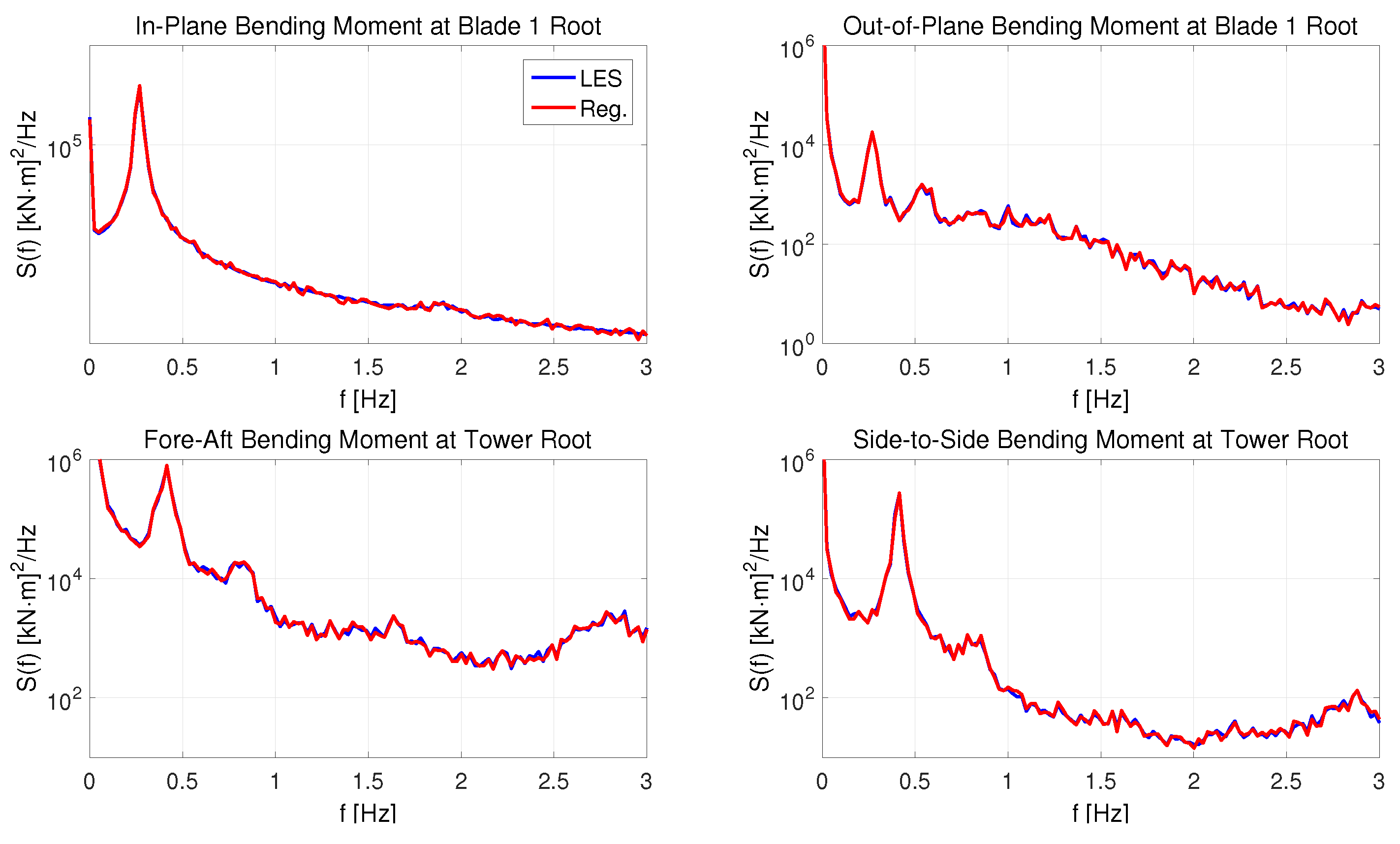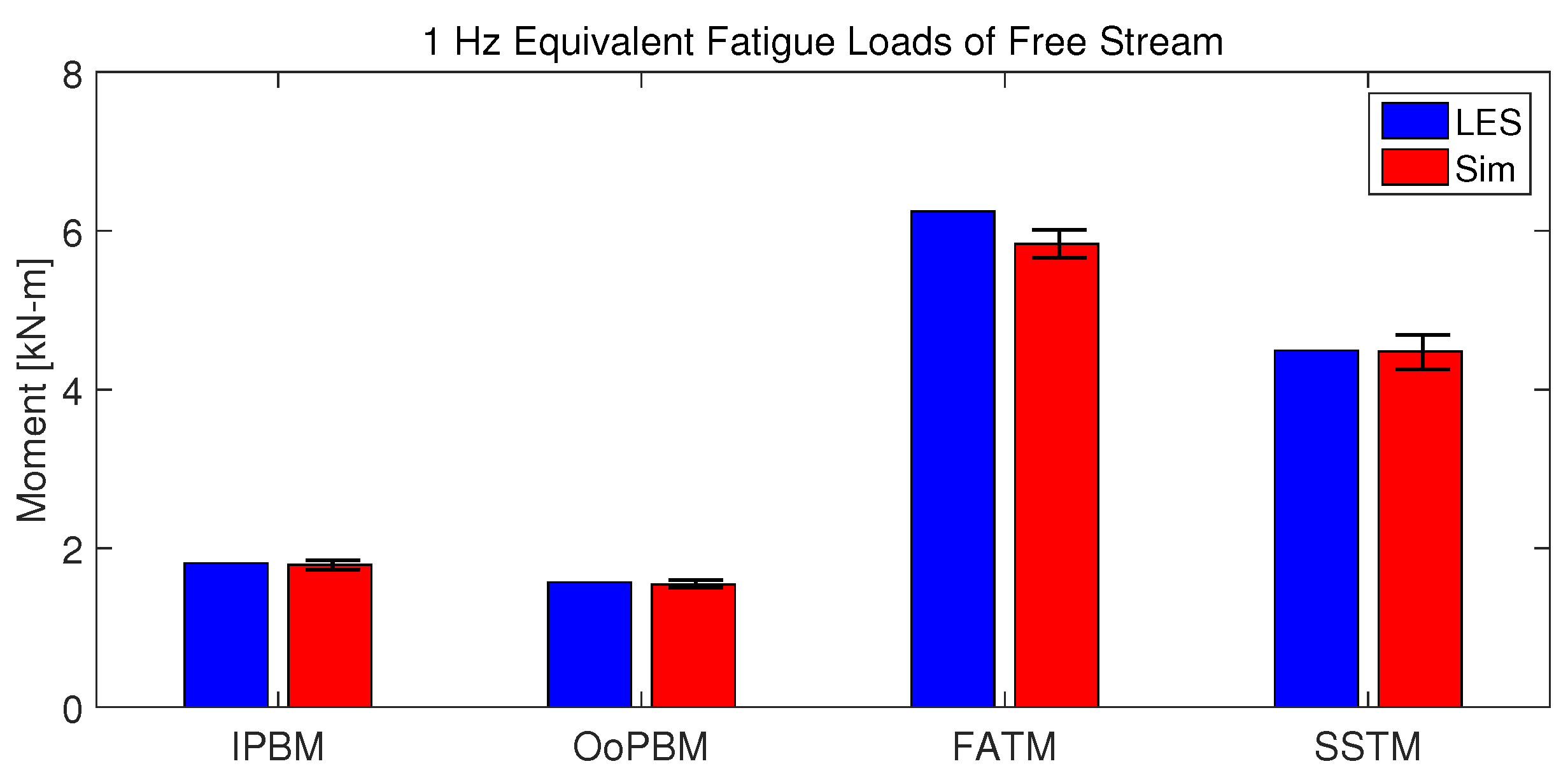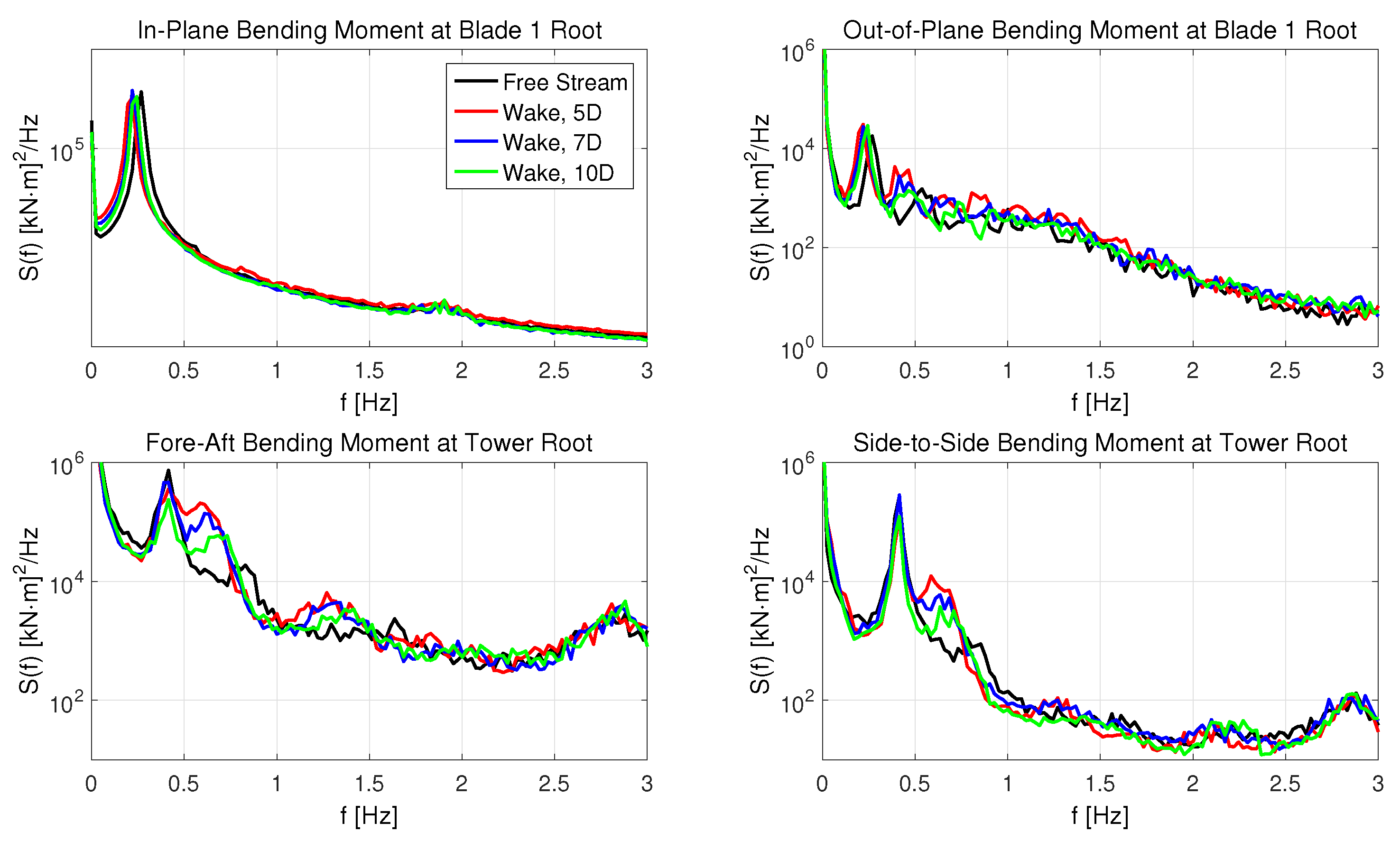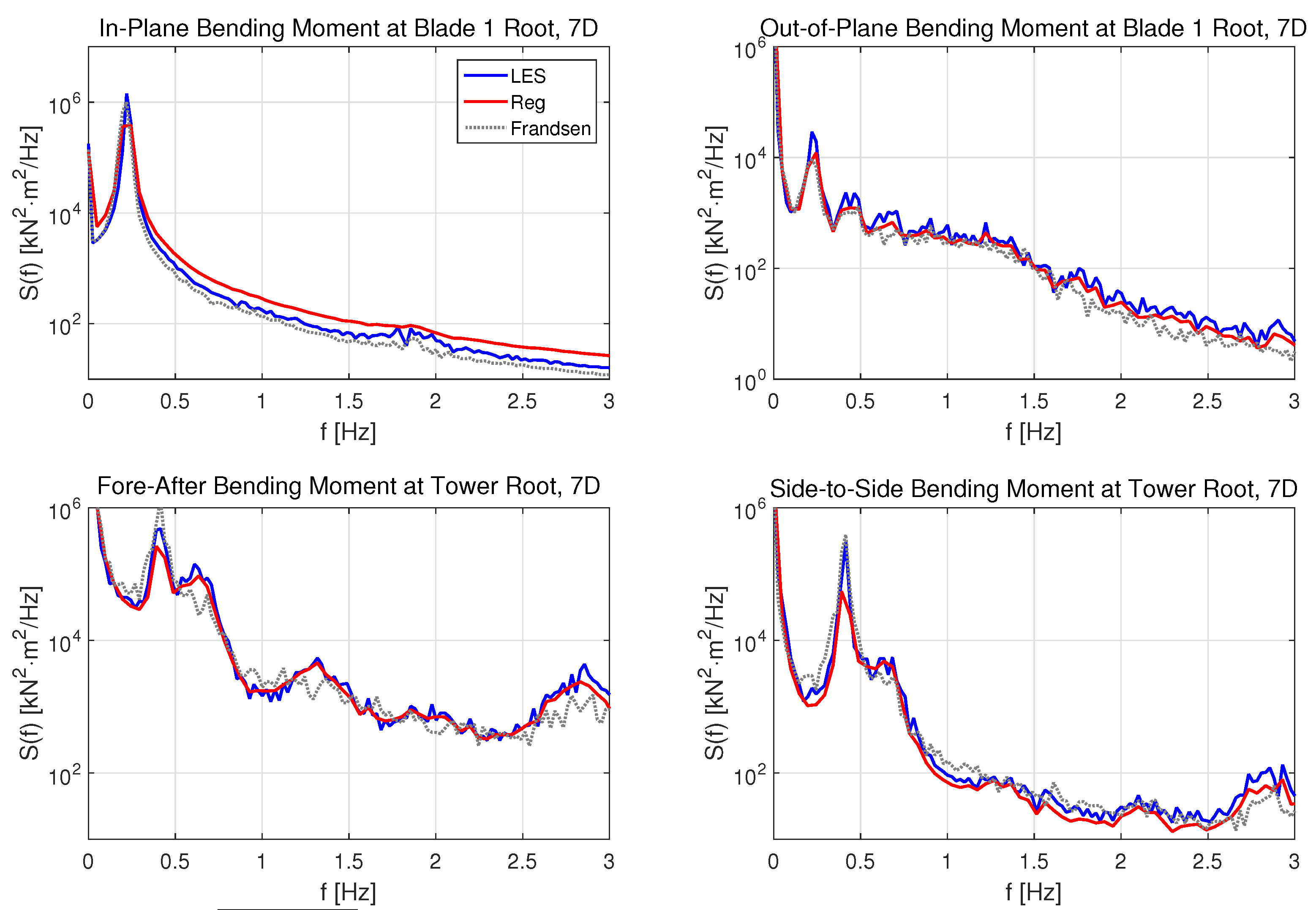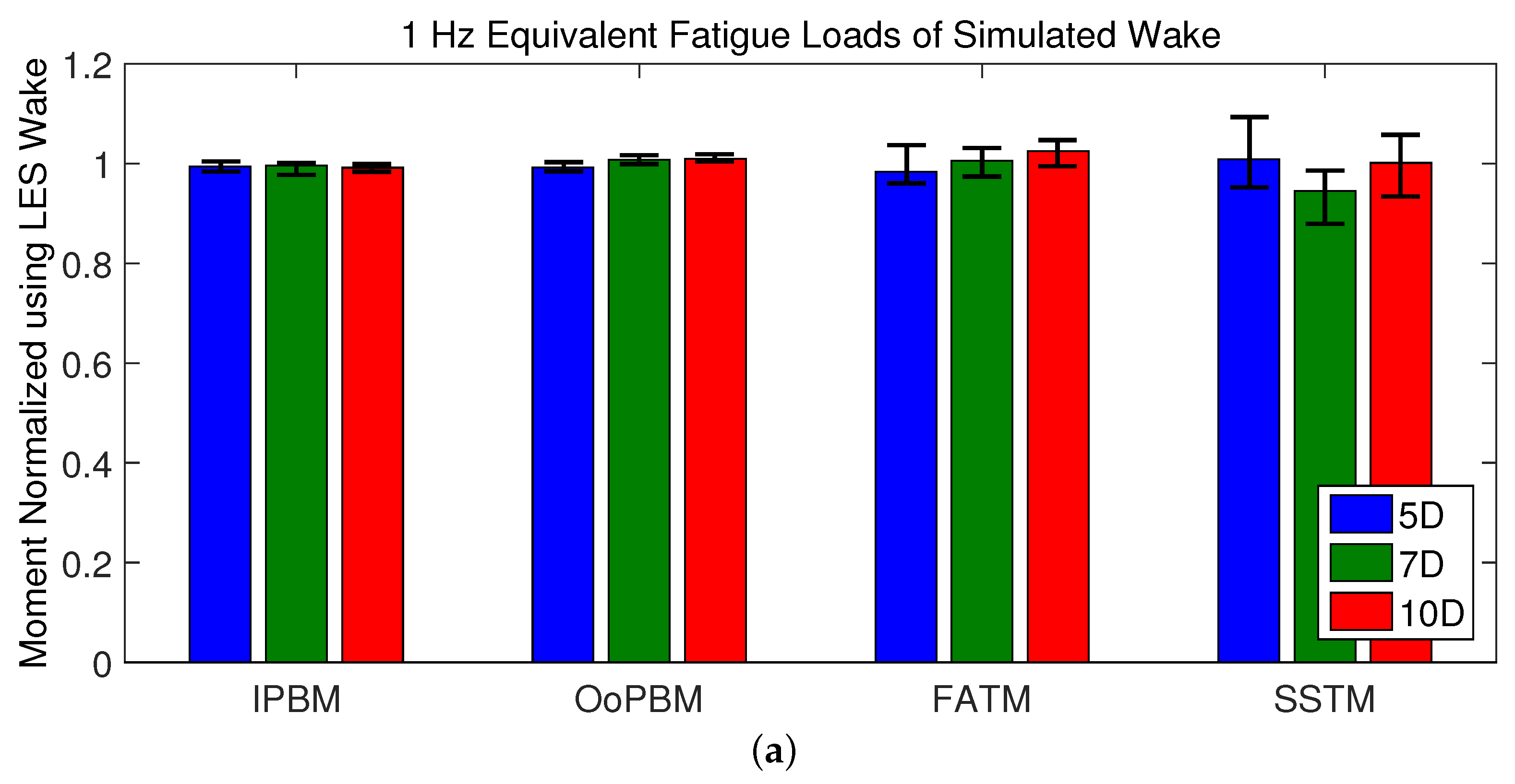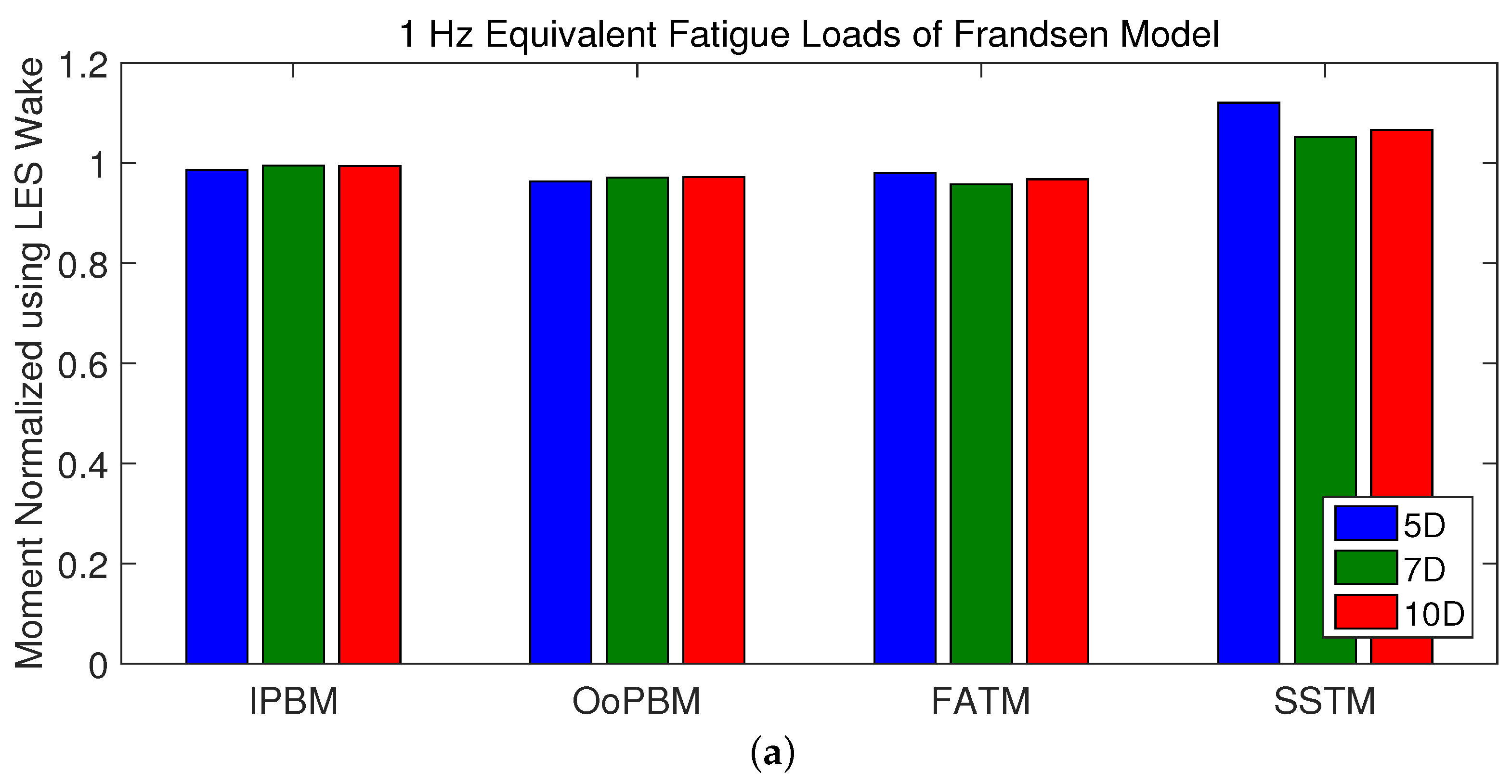Figure 1.
Dimensions of the computational domain.
Figure 1.
Dimensions of the computational domain.
Figure 2.
A horizontal plane through the free-stream wind velocity field near the ground ( m).
Figure 2.
A horizontal plane through the free-stream wind velocity field near the ground ( m).
Figure 3.
Variation in a vertical plane of the free-stream wind velocity mean and standard deviation.
Figure 3.
Variation in a vertical plane of the free-stream wind velocity mean and standard deviation.
Figure 4.
Power spectra for the three free-stream turbulence components at different heights.
Figure 4.
Power spectra for the three free-stream turbulence components at different heights.
Figure 5.
Power spectra for the three free-stream turbulence components; different locations.
Figure 5.
Power spectra for the three free-stream turbulence components; different locations.
Figure 6.
Coherence functions for the three free-stream turbulence components with the same lateral separation (19.25 m) at different elevations.
Figure 6.
Coherence functions for the three free-stream turbulence components with the same lateral separation (19.25 m) at different elevations.
Figure 7.
Spatial variation in the waked field versus the free-stream field: (a) variation of in vertical planes; and (b) profile of .
Figure 7.
Spatial variation in the waked field versus the free-stream field: (a) variation of in vertical planes; and (b) profile of .
Figure 8.
Spatial variation in the waked field versus the free-stream field: (a) variation of in vertical planes; and (b) profile of .
Figure 8.
Spatial variation in the waked field versus the free-stream field: (a) variation of in vertical planes; and (b) profile of .
Figure 9.
Spatial variation in the waked field versus the free-stream field: (a) variation of in vertical planes; and (b) profile of .
Figure 9.
Spatial variation in the waked field versus the free-stream field: (a) variation of in vertical planes; and (b) profile of .
Figure 10.
Spatial variation in the waked field versus the free-stream field: (a) variation of in vertical planes; and (b) profile of .
Figure 10.
Spatial variation in the waked field versus the free-stream field: (a) variation of in vertical planes; and (b) profile of .
Figure 11.
Power spectral density functions of u at , 5D, 7D, and 10D: (a) lateral variation; and (b) vertical variation.
Figure 11.
Power spectral density functions of u at , 5D, 7D, and 10D: (a) lateral variation; and (b) vertical variation.
Figure 12.
Power spectral density functions of v at , 5D, 7D, and 10D: (a) lateral variation; and (b) vertical variation.
Figure 12.
Power spectral density functions of v at , 5D, 7D, and 10D: (a) lateral variation; and (b) vertical variation.
Figure 13.
Power spectral density functions of w at , 5D, 7D, and 10D: (a) lateral variation; and (b) vertical variation.
Figure 13.
Power spectral density functions of w at , 5D, 7D, and 10D: (a) lateral variation; and (b) vertical variation.
Figure 14.
Free-stream mean profiles: regression vs. Large-Eddy Simulation (LES) data: (a) free-stream u component mean profile; and (b) free-stream v component mean profile.
Figure 14.
Free-stream mean profiles: regression vs. Large-Eddy Simulation (LES) data: (a) free-stream u component mean profile; and (b) free-stream v component mean profile.
Figure 15.
Free-stream standard deviation profiles: regression vs. LES data.
Figure 15.
Free-stream standard deviation profiles: regression vs. LES data.
Figure 16.
Free-stream PSD length scale profiles: regression vs. LES data.
Figure 16.
Free-stream PSD length scale profiles: regression vs. LES data.
Figure 17.
Coordinate system definition for reference.
Figure 17.
Coordinate system definition for reference.
Figure 18.
Spatial variation of : LES versus regression-based estimation.
Figure 18.
Spatial variation of : LES versus regression-based estimation.
Figure 19.
Spatial variation of : LES versus regression-based estimation.
Figure 19.
Spatial variation of : LES versus regression-based estimation.
Figure 20.
Spatial variation of : LES versus regression-based estimation.
Figure 20.
Spatial variation of : LES versus regression-based estimation.
Figure 21.
Spatial variation of : LES versus regression-based estimation.
Figure 21.
Spatial variation of : LES versus regression-based estimation.
Figure 22.
Spatial variation of : LES versus regression-based estimation.
Figure 22.
Spatial variation of : LES versus regression-based estimation.
Figure 23.
Spatial variation of : LES versus regression-based estimation.
Figure 23.
Spatial variation of : LES versus regression-based estimation.
Figure 24.
Spatial variation of : LES versus regression-based estimation.
Figure 24.
Spatial variation of : LES versus regression-based estimation.
Figure 25.
Spatial variation of : LES versus regression-based estimation.
Figure 25.
Spatial variation of : LES versus regression-based estimation.
Figure 26.
Spatial variation of : LES versus regression-based estimation.
Figure 26.
Spatial variation of : LES versus regression-based estimation.
Figure 27.
Spectra of turbine loads from simulated free stream.
Figure 27.
Spectra of turbine loads from simulated free stream.
Figure 28.
1-Hz equivalent fatigue loads in the free stream based on LES and on stochastic simulation.
Figure 28.
1-Hz equivalent fatigue loads in the free stream based on LES and on stochastic simulation.
Figure 29.
Power spectra of turbine loads in the free stream and wake based on LES.
Figure 29.
Power spectra of turbine loads in the free stream and wake based on LES.
Figure 30.
Normalized 1 Hz equivalent fatigue loads of wake.
Figure 30.
Normalized 1 Hz equivalent fatigue loads of wake.
Figure 31.
Power spectra of turbine loads in the wake at based on LES and the stochastic model.
Figure 31.
Power spectra of turbine loads in the wake at based on LES and the stochastic model.
Figure 32.
Power spectra of turbine loads in the wake at based on LES and the stochastic model.
Figure 32.
Power spectra of turbine loads in the wake at based on LES and the stochastic model.
Figure 33.
Power spectra of turbine loads in the wake at based on LES and the stochastic model.
Figure 33.
Power spectra of turbine loads in the wake at based on LES and the stochastic model.
Figure 34.
Normalized 1-Hz equivalent fatigue loads. (a) stochastic simulation; (b) Frandsen model.
Figure 34.
Normalized 1-Hz equivalent fatigue loads. (a) stochastic simulation; (b) Frandsen model.
Table 1.
Free-stream mean profile regression results.
Table 1.
Free-stream mean profile regression results.
| Parameter | | | | | | |
|---|
| Value | 8.19 m/s | 80 m | 0.1489 | −0.088 m/s | 0.0276 | −0.019 m/s |
Table 2.
Free-stream standard deviation profile regression results.
Table 2.
Free-stream standard deviation profile regression results.
| Parameter | | | | | | |
|---|
| Value | 0.8045 m/s | −0.0016 | 0.6447 m/s | −0.0016 | 0.5641 m/s | −0.0008 |
Table 3.
Free-stream length scale regression results.
Table 3.
Free-stream length scale regression results.
| Parameter | | | | |
|---|
| Value | 0.2 m | 0.679 m | 0.246 m | 0.221 m |
Table 4.
wake mean field regression results.
Table 4.
wake mean field regression results.
| | | | | |
| 0.0790 | −0.0026 | −0.1905 | 1.1009 | 0.0245 |
| −0.0240 | 0.0016 | −0.0941 | −0.0431 | 0.1624 |
| 0.0038 | −0.0004 | 0.0113 | −0.1792 | −0.0479 |
| | | | | | |
| | 1.3002 | 0.0117 | −0.0070 | −0.0645 | 0.0176 |
| | 0.0163 | 0.0055 | −0.0018 | 0.2674 | −0.0117 |
| | −0.0789 | 0.0007 | 0.0045 | −0.0066 | 0.0047 |
Table 5.
Coefficients of determination for .
Table 5.
Coefficients of determination for .
| | | | |
|---|
| 0.7772 | 0.7396 | 0.4393 |
Table 6.
Importance of variables in regression.
Table 6.
Importance of variables in regression.
| p Value | | | | | |
| 0.1126 | 0.4325 | 0.0029 | 0 | 0.7032 |
| 0.0548 | 0.0454 | 0 | 0 | 0 |
| 0.7565 | 0.6171 | 0.4779 | 0 | 0.0028 |
| | | | | | |
| | 0 | 0.1633 | 0.4090 | 0.0462 | |
| | 0.0764 | 0.0084 | 0.3992 | 0 | |
| | 0 | 0.7447 | 0.1338 | 0.0006 | |
Table 7.
wake standard deviation regression results.
Table 7.
wake standard deviation regression results.
| | | | | |
| −0.0458 | 0.0012 | −0.0741 | −0.0815 | 0.2488 |
| −0.0131 | 0.0001 | −0.0090 | −0.0827 | 0.1462 |
| −0.0149 | −0.0001 | −0.0164 | −0.0859 | 0.0509 |
| | | | | | |
| | −0.0944 | 0.0030 | −0.0017 | 0.0026 | −0.0078 |
| | −0.0819 | 0.0009 | −0.0016 | −0.0154 | 0.0032 |
| | −0.2299 | -0.0004 | 0.0058 | −0.0037 | −0.0009 |
Table 8.
Coefficients of determination for .
Table 8.
Coefficients of determination for .
| | | | |
|---|
| 0.7030 | 0.7426 | 0.7530 |
Table 9.
Importance of variables in regression.
Table 9.
Importance of variables in regression.
| p-Value | | | | | |
| 0.0211 | 0.3517 | 0.0036 | 0 | 0 |
| 0.1926 | 0.9211 | 0.4837 | 0 | 0 |
| 0.1551 | 0.8967 | 0.2190 | 0 | 0.0002 |
| | | | | | |
| | 0 | 0.3690 | 0.6214 | 0 | |
| | 0 | 0.6132 | 0.3323 | 0.2079 | |
| | 0 | 0.8267 | 0.0011 | 0.1308 | |
Table 10.
wake integral length scale regression results.
Table 10.
wake integral length scale regression results.
| | | | | |
| −6.5286 | 0.3994 | −5.3498 | 22.2887 | −23.9192 |
| 1.4229 | −0.0950 | 1.4318 | 0.9628 | −18.9324 |
| −1.9086 | 0.1194 | 1.5593 | 0.8695 | −20.8400 |
| | | | | | |
| | 25.4228 | 0.4260 | −2.1783 | 18.9252 | −3.2913 |
| | 7.2252 | −0.0491 | −0.7312 | −0.3142 | 0.1277 |
| | 5.3847 | −0.2158 | −0.0998 | 2.1160 | −0.2827 |
Table 11.
Coefficients of determination for .
Table 11.
Coefficients of determination for .
| | | | |
|---|
| 0.5005 | 0.8627 | 0.9121 |
Table 12.
Importance of variables in regression.
Table 12.
Importance of variables in regression.
| p-Value | | | | | |
| 0.1789 | 0.2107 | 0.3892 | 0 | 0.0001 |
| 0.1949 | 0.1880 | 0.3082 | 0.2279 | 0 |
| 0.0115 | 0.0161 | 0.1065 | 0.1131 | 0 |
| | | | | | |
| | 0 | 0.6013 | 0.0083 | 0.0997 | |
| | 0 | 0.7902 | 0.0001 | 0.3839 | |
| | 0 | 0.0890 | 0.4347 | 0.9310 | |
Table 13.
The WindPACT 1.5-MW wind turbine model.
Table 13.
The WindPACT 1.5-MW wind turbine model.
| Parameter | Value |
|---|
| Configuration | 3 blades, upwind |
| Rotor diameter | 70 m |
| Hub height | 84 m |
| Drivetrain | High speed, multiple-stage gearbox |
| Control | Variable speed and pitch control |
| Max. rotor speed | 20.5 rpm |
| Rated wind speed | 11.8 m/s |
| Cut-out wind speed | 25 m/s |
| Tower nat. frequency | 0.387 Hz |
Table 14.
Turbine load statistics in the free stream: Large Eddy Simulation (LES) vs. stochastic model.
Table 14.
Turbine load statistics in the free stream: Large Eddy Simulation (LES) vs. stochastic model.
| Loads (LES/Sim) [kN-m] | IPBM | OoPBM | FATM | SSTM |
|---|
| Std.dev | 324/322 | 97/95 | 1042/1035 | 186/184 |
| Max | 594/592 | 1285/1263 | 14130/14088 | 1092/1087 |
Table 15.
Turbine load statistics in the wake: LES model.
Table 15.
Turbine load statistics in the wake: LES model.
| Loads [kN-m] | IPBM | OoPBM | FATM | SSTM |
|---|
| Free Stream | Std.dev | 324 | 97 | 1142 | 186 |
| Max | 594 | 1285 | 14130 | 1092 |
| 5D | Std.dev | 325 | 93 | 825 | 175 |
| Max | 578 | 988 | 9001 | 988 |
| 7D | Std.dev | 324 | 92 | 964 | 183 |
| Max | 572 | 1008 | 9847 | 974 |
| 10D | Std.dev | 325 | 93 | 971 | 175 |
| Max | 583 | 1063 | 10710 | 977 |
Table 16.
Standard deviation and maximum of various turbine loads from stochastic vs. LES waked wind fields vs. Frandsen wake model.
Table 16.
Standard deviation and maximum of various turbine loads from stochastic vs. LES waked wind fields vs. Frandsen wake model.
| Loads (Sim/LES/Frandsen) | IPBM | OoPBM | FATM | SSTM |
|---|
| 5D | Std.dev | 324/325/322 | 106/93/111 | 1005/825/1208 | 168/175/192 |
| Max | 568/578/561 | 985/988/917 | 9437/9001/9706 | 846/988/1061 |
| 7D | Std.dev | 325/324/323 | 104/92/96 | 1064/ 964/1102 | 152/183/185 |
| Max | 566/572/567 | 1028/1008/1016 | 10210/9847/10760 | 816/974/958 |
| 10D | Std.dev | 325/325/324 | 102/93/96 | 1088/971/1122 | 143/175/183 |
| Max | 569/583/571 | 1063/1063/1076 | 10807/10710/11060 | 826/977/958 |
